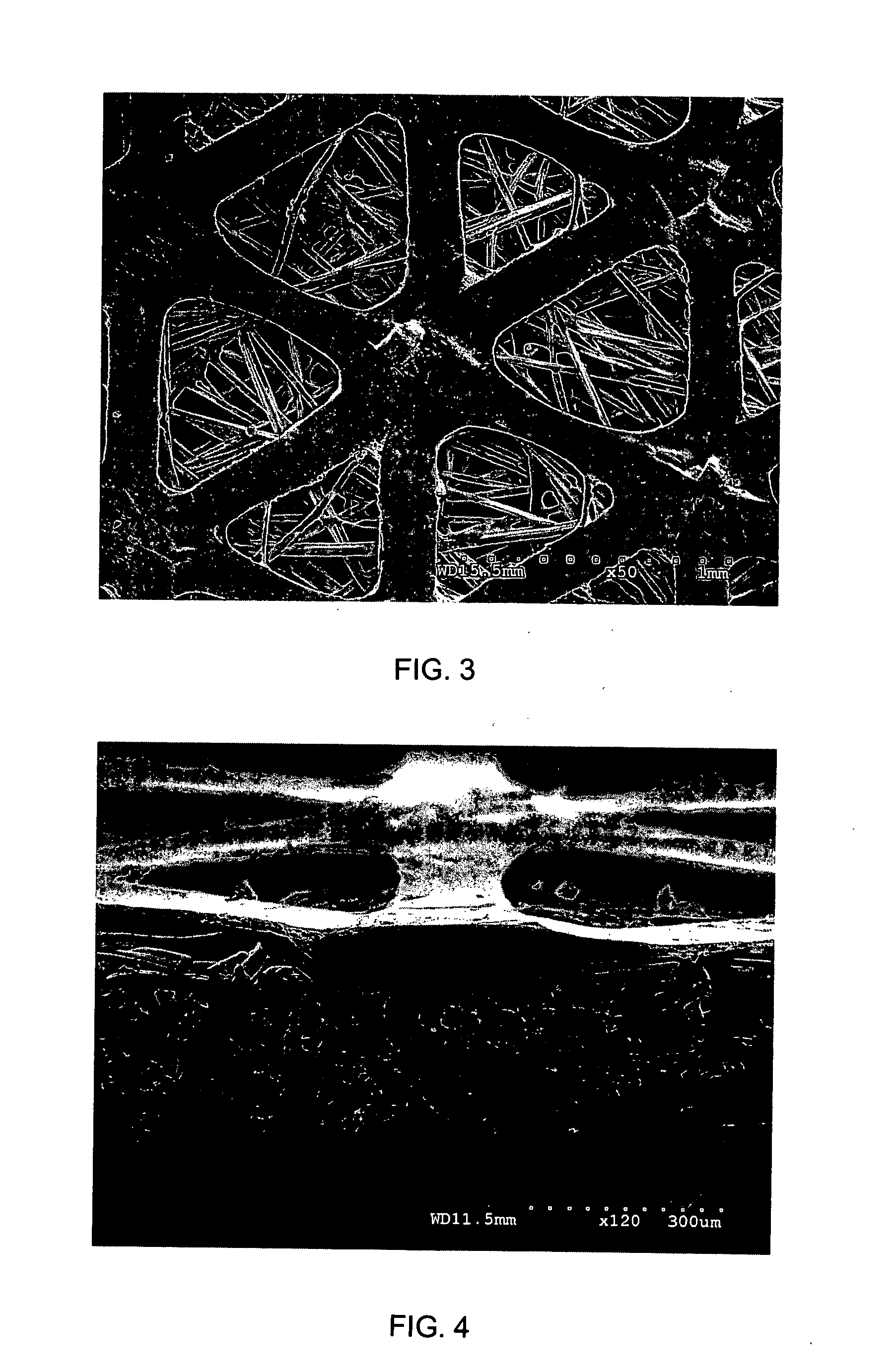Composite fabric with controlled release of functional chemicals
a technology of functional chemicals and composite fabrics, applied in the field of nonwoven fabrics, can solve the problems of adding to the cost of producing filtration media, nonwoven fabrics, and dyeing fibers, and is not a viable option for nonwoven fabric manufacturing processes
- Summary
- Abstract
- Description
- Claims
- Application Information
AI Technical Summary
Benefits of technology
Problems solved by technology
Method used
Image
Examples
example 1
[0035] A roll of spunbond polyester nonwoven fabric filtration medium produced by BBA Nonwovens as Reemay® grade 2033 having the properties shown in Table 1 below was placed on an unwind stand. The nonwoven fabric filtration medium is formed from polyethylene terephthalate filaments of a generally trilobal cross-section having a linear density of 4 denier per filament. The fabric is area bonded by a polyethylene isophthalate copolymer binder. A roll of apertured high density polyethylene film produced by DelStar Technologies, Inc. and having the properties shown in Table 1 was mounted on a second unwind stand. As the nonwoven fabric was unrolled from the roll, the film was unrolled and directed onto one surface of the nonwoven fabric filtration. These two layers were directed through a nip formed by heated smooth-surfaced calender rolls to laminate the film layer to the nonwoven fabric layer, producing a composite filtration medium having the basis weight, thickness and air permeabi...
example 2
[0036] Samples of the composite filtration medium of Example 1 were subjected to testing for compliance with the National Sanitation Foundation (NSF) requirements for pool and spa filters. The samples were tested in accordance with FDA standard 21 C.F.R. §177.1630 for polyester fabrics and 21 C.F.R. §177.1520 for polyolefin fabrics for extractives. The extractives were well under the limits specified in these regulations, as seen in the following table.
TestStandardSampleSampleSample21 CFRMax.ChloroformChloroformChloroform177.1630chloroform-solublesolublesolublesolubleextractivesextractivesextractivesextractivesfrom waterfrom heptanefrom 50% ethanol0.20.00000.01440.030821 CFRMax.Extractable177.1520extractablefraction infraction inn-hexanen-hexane6.40.0556Max.Extractableextractablefraction infraction inxylenexylene9.81.31
example 3
[0037] The turbidity reduction and the plug time characteristics of the composite filtration medium of Example 1 were compared to a control sample formed of the Reemay 2033 spunbond nonwoven fabric alone. Turbidity reduction was measured in accordance with the NSF / ANSI Standard 50. Plug time was evaluated by monitoring the pressure drop across the filter versus time. Comparative results show that the composite medium of the invention exhibits turbidity reduction comparable to that of the control, and that the additional presence of the apertured film layer did not alter the pressure drop across the filter during normal operation and did not significantly reduce the plug time. After the plug time test, the two samples were rinsed to remove the accumulated filter cake. The filter cake was readily removed from the composite filtration medium of the invention by rinsing under running water. In the control sample, some of the filter cake was rinsed off, but some remained adhered to the c...
PUM
| Property | Measurement | Unit |
|---|---|---|
| thickness | aaaaa | aaaaa |
| thickness | aaaaa | aaaaa |
| weight percent | aaaaa | aaaaa |
Abstract
Description
Claims
Application Information
 Login to View More
Login to View More - R&D
- Intellectual Property
- Life Sciences
- Materials
- Tech Scout
- Unparalleled Data Quality
- Higher Quality Content
- 60% Fewer Hallucinations
Browse by: Latest US Patents, China's latest patents, Technical Efficacy Thesaurus, Application Domain, Technology Topic, Popular Technical Reports.
© 2025 PatSnap. All rights reserved.Legal|Privacy policy|Modern Slavery Act Transparency Statement|Sitemap|About US| Contact US: help@patsnap.com



